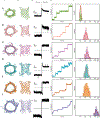Sculpting conducting nanopore size and shape through de novo protein design
- PMID: 39024453
- PMCID: PMC11549965
- DOI: 10.1126/science.adn3796
Sculpting conducting nanopore size and shape through de novo protein design
Abstract
Transmembrane β-barrels have considerable potential for a broad range of sensing applications. Current engineering approaches for nanopore sensors are limited to naturally occurring channels, which provide suboptimal starting points. By contrast, de novo protein design can in principle create an unlimited number of new nanopores with any desired properties. Here we describe a general approach to designing transmembrane β-barrel pores with different diameters and pore geometries. Nuclear magnetic resonance and crystallographic characterization show that the designs are stably folded with structures resembling those of the design models. The designs have distinct conductances that correlate with their pore diameter, ranging from 110 picosiemens (~0.5 nanometer pore diameter) to 430 picosiemens (~1.1 nanometer pore diameter). Our approach opens the door to the custom design of transmembrane nanopores for sensing and sequencing applications.
Conflict of interest statement
Figures




Update of
-
Sculpting conducting nanopore size and shape through de novo protein design.bioRxiv [Preprint]. 2023 Dec 20:2023.12.20.572500. doi: 10.1101/2023.12.20.572500. bioRxiv. 2023. Update in: Science. 2024 Jul 19;385(6706):282-288. doi: 10.1126/science.adn3796. PMID: 38187764 Free PMC article. Updated. Preprint.
References
MeSH terms
Grants and funding
LinkOut - more resources
Full Text Sources

